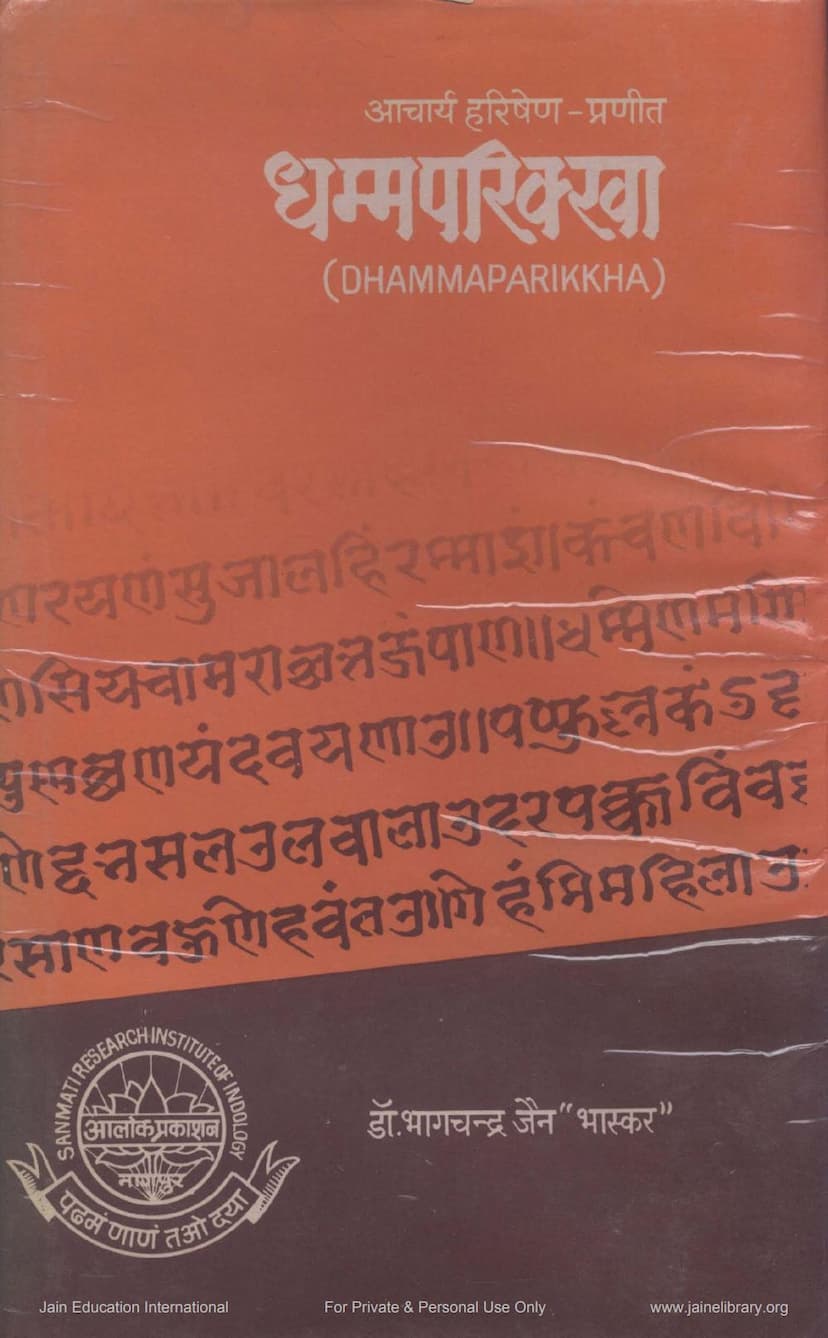Dhammaparikkha
Added to library: September 1, 2025

Summary
Here is a comprehensive summary of the Jain text "Dhammaparikkha" by Bhagchandra Jain Bhaskar, based on the provided pages:
Book Title: Dhammaparikkha (धम्मपरिक्खा) Author of the original text: Acharya Harishena Editor and Publisher: Dr. Bhagchandra Jain 'Bhaskar', Sanmati Research Institute of Indology, Nagpur. Publication Year: 1990
Overview:
The "Dhammaparikkha" is a significant work in the tradition of "Dhurta-akhyana" literature. It is an allegorical epic poem composed in Apabhramsha that primarily aims to refute the philosophical views and mythological narratives of other religious traditions, particularly Vedic ones, through scholarly debate and logical reasoning. The central objective is to expose the contradictions, exaggerations, and irrationalities in these narratives and establish the truth and correctness of Jain principles, such as non-violence (Ahimsa) and right knowledge (Samyak-jnana).
Author and Context:
- Acharya Harishena: The original author, Acharya Harishena, was a Mahakavi (great poet) of the 10th century. He composed the work in eleven "Sandhis" (sections).
- Purpose: The "Dhammaparikkha" aims to correct wrong views (Micchattabhava) that hinder spiritual development. It seeks to guide individuals towards the right path through self-realization and logical analysis, rather than through insult or condemnation of other beliefs.
- Style: The language is Apabhramsha, and the style is engaging and entertaining. The dominant rasa is Shanta (peace), with effective use of rhetorical devices like metaphors (Rupak), similes (Upama), and hyperbole (Utpreksha).
Key Themes and Content:
-
The Narrative Framework: The story centers on two close friends: Manovega, a devout Jain prince, and Pavanavega, a prince following Vedic traditions. Manovega undertakes the mission to guide Pavanavega towards the right path by exposing the flaws in Vedic mythology through reasoned arguments.
-
Critique of Pauranik (Mythological) Narratives: A core element of the "Dhammaparikkha" is the critical examination and refutation of numerous Pauranik stories prevalent during Harishena's time. These include:
- The story of Pavanavega's friend Manovega and the illustration of the "Madhu Bindu" (drop of honey) to explain the nature of worldly pleasure and suffering.
- Various mythological tales involving gods like Vishnu, Brahma, Shiva, Indra, and sages like Parasara, Uddalaka, and others, highlighting their human-like desires, flaws, and inconsistent actions.
- Specific stories analyzed include: Bali Bandhan (Akampanacharya Muni), Marjar Katha (Cat Story), Mandapakaushik and Chhaya, Tilottama, Shishnachedan (circumcision), Kharashirshachedan (donkey head cutting), Jalashila and Vanaranrutya (water stone and monkey dance), Kamalndal and Gaja (water pot and elephant), and the story of Puranas' questioning of characters like Ravana.
-
Logical Debate (Shastrartha): The text is structured around debates where Manovega presents Pauranik narratives and then logically dismantles them, often by presenting parallel Jain narratives or pointing out internal inconsistencies. This is done to prove their unreliability and uphold Jain principles.
-
Pavanavega's Transformation: Through Manovega's arguments and the exposition of Jain philosophy, Pavanavega undergoes a profound heart change and eventually embraces Jainism.
-
Jain Philosophy and Practices: The text elaborates on essential Jain concepts:
- Apta (Reliable Authority): Critiquing the divine status of Pauranik deities, the text emphasizes the true nature of an Apta as a pure, omniscient, passionless (Vitaraaga) being, as embodied by the Jinas.
- Ethical Principles: The importance of non-violence (Ahimsa), truthfulness, non-stealing, celibacy, and non-possession is highlighted.
- Sravaka Vratas (Lay Vows): The text details the vows taken by Jain lay followers, including the eight primary virtues (Ashta Mulgunas) and the twelve vows, emphasizing practices like abstaining from night meals (Ratribhojan Tyag) and the significance of ethical conduct.
-
Structure and Style: The "Dhammaparikkha" is divided into eleven Sandhis, containing a total of 238 Kadavakas (verses) in an epic style. The narrative flows through these sections, developing the characters and the philosophical arguments.
Editorial Contribution:
The presented edition, edited by Dr. Bhagchandra Jain 'Bhaskar', is based on two ancient manuscripts. It includes a detailed introduction, grammatical analysis of the Apabhramsha language, and a comprehensive commentary (Bhavanuvad). The editor's work is crucial for making this ancient text accessible to modern readers.
Significance:
The "Dhammaparikkha" is notable for its scholarly approach to religious critique and its contribution to Apabhramsha literature. It exemplifies the Jain tradition of engaging in philosophical discourse with a focus on truth and non-violence, aiming for genuine spiritual understanding and transformation. The work stands as a testament to the intellectual rigor and literary prowess of Jain Acharyas in defending and propagating their philosophy.